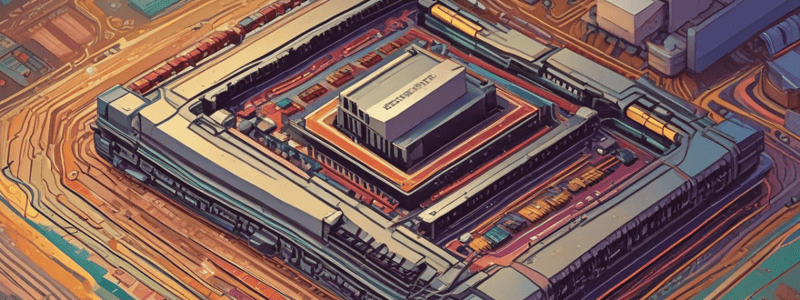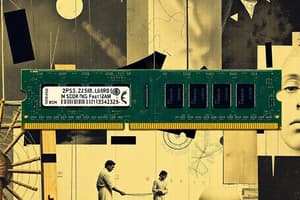Podcast
Questions and Answers
What is the primary innovation of DDR SDRAM?
What is the primary innovation of DDR SDRAM?
- Transferring data on the rising edge of the clock signal
- Transferring data on the falling edge of the clock signal
- Transferring data only when the clock signal is steady
- Transferring data on both rising and falling edges of the clock signal (correct)
What is the voltage reduction from DDR2 to DDR3?
What is the voltage reduction from DDR2 to DDR3?
- From 1.8 to 1.5 V (correct)
- From 1.2 to 1 V
- From 1.5 to 1.2 V
- From 2.5 to 1.8 V
What is the maximum expected clock rate of DDR4?
What is the maximum expected clock rate of DDR4?
- 1333 MHz
- 1600 MHz (correct)
- 1000 MHz
- 800 MHz
How are memories usually sold?
How are memories usually sold?
What is the function of the activate command (ACT) in DRAM operation?
What is the function of the activate command (ACT) in DRAM operation?
How is the address multiplexing managed in DRAM operation?
How is the address multiplexing managed in DRAM operation?
What is the organization of modern DRAM?
What is the organization of modern DRAM?
What is the purpose of the precharge command (PRE) in DRAM operation?
What is the purpose of the precharge command (PRE) in DRAM operation?
What is the purpose of memory interleaving?
What is the purpose of memory interleaving?
What is the primary function of virtual memory?
What is the primary function of virtual memory?
What is the bus width of a typical DDR memory module?
What is the bus width of a typical DDR memory module?
What happens when a row is not open in main memory?
What happens when a row is not open in main memory?
What is the clock rate of DDR1 memory in MiB per second?
What is the clock rate of DDR1 memory in MiB per second?
What is the term used to describe the process of translating virtual addresses to physical addresses?
What is the term used to describe the process of translating virtual addresses to physical addresses?
What is the benefit of virtual memory in terms of memory space?
What is the benefit of virtual memory in terms of memory space?
What is the term used to describe a block of memory in the context of virtual memory?
What is the term used to describe a block of memory in the context of virtual memory?
What is the main priority of SRAM?
What is the main priority of SRAM?
What is the benefit of using SRAM in cache memory?
What is the benefit of using SRAM in cache memory?
What is the consequence of quadrupling the memory bus?
What is the consequence of quadrupling the memory bus?
What is the term for data that needs to be refreshed periodically in DRAM?
What is the term for data that needs to be refreshed periodically in DRAM?
What is the main advantage of using SDRAM over traditional DRAM?
What is the main advantage of using SDRAM over traditional DRAM?
What is the result of using a 256-bit bus without interleaving?
What is the result of using a 256-bit bus without interleaving?
What is the speedup of using a 256-bit bus without interleaving compared to a memory interleaving configuration of 4 banks?
What is the speedup of using a 256-bit bus without interleaving compared to a memory interleaving configuration of 4 banks?
What is the characteristic of EEPROM?
What is the characteristic of EEPROM?
What is the primary reason why the common approximation considers each bit corresponding to a single way in the cache?
What is the primary reason why the common approximation considers each bit corresponding to a single way in the cache?
According to Figure 4.7, which cache replacement strategy results in the lowest number of cache misses in a 256 kBytes two-way associative cache?
According to Figure 4.7, which cache replacement strategy results in the lowest number of cache misses in a 256 kBytes two-way associative cache?
What is the primary advantage of making reads faster in cache memory?
What is the primary advantage of making reads faster in cache memory?
Why is it not possible to apply the strategy of reading blocks from the cache simultaneously with tag comparison to writes?
Why is it not possible to apply the strategy of reading blocks from the cache simultaneously with tag comparison to writes?
In a fully associative cache, what determines the placement of a block?
In a fully associative cache, what determines the placement of a block?
What is the main purpose of a cache replacement policy?
What is the main purpose of a cache replacement policy?
What is the main advantage of a fully associative cache?
What is the main advantage of a fully associative cache?
What happens when all the bits related to a set in the cache are turned ON?
What happens when all the bits related to a set in the cache are turned ON?
What is the primary advantage of using a set associative cache?
What is the primary advantage of using a set associative cache?
In a direct mapped cache, how is the cache block determined for a given block address?
In a direct mapped cache, how is the cache block determined for a given block address?
What is the main disadvantage of a direct mapped cache?
What is the main disadvantage of a direct mapped cache?
What is the main characteristic of a cache replacement policy based on the random strategy?
What is the main characteristic of a cache replacement policy based on the random strategy?
In a set associative cache, how is the set determined for a given block address?
In a set associative cache, how is the set determined for a given block address?
What is the term used to describe a cache with n blocks in a set?
What is the term used to describe a cache with n blocks in a set?
What is the main advantage of a set associative cache over a direct mapped cache?
What is the main advantage of a set associative cache over a direct mapped cache?
What is the purpose of a replacing policy in a cache?
What is the purpose of a replacing policy in a cache?
What is the primary function of the tag in a cache memory?
What is the primary function of the tag in a cache memory?
In a fully associative cache, how many replacement strategies are commonly used?
In a fully associative cache, how many replacement strategies are commonly used?
What is the principle behind the LRU replacement strategy?
What is the principle behind the LRU replacement strategy?
What is the main drawback of the LRU strategy?
What is the main drawback of the LRU strategy?
What is the advantage of using FIFO replacement strategy over LRU?
What is the advantage of using FIFO replacement strategy over LRU?
In a direct mapped cache, how is the block replacement performed?
In a direct mapped cache, how is the block replacement performed?
What is the main advantage of using a fully associative cache over a direct mapped cache?
What is the main advantage of using a fully associative cache over a direct mapped cache?
What is the main characteristic of the cache memory?
What is the main characteristic of the cache memory?
Flashcards are hidden until you start studying
Study Notes
DDR SDRAM Technology
- DDR SDRAM transfers data on both rising and falling edges of the clock signal, hence the term "double data rate".
- DDR technology has evolved with increased clock rates and voltage reduction:
- From DDR1 to DDR2, voltage reduced from 2.5V to 1.8V, and clock rates increased to 266, 333, and 400 MHz.
- From DDR2 to DDR3, voltage dropped to 1.5V with a maximum clock speed of 800 MHz.
- From DDR3 to DDR4, voltage dropped to 1-1.2V with a maximum expected clock rate of 1600 MHz.
- DDR5 standard was released in 2020.
- Memories are usually sold in small boards called dual inline memory module (DIMM), containing 4 to 16 DRAM chips, arranged to provide 8-Byte words.
DRAM Organization and Operation
- Modern DRAM is organized in banks with up to 16 banks in DDR4, each bank having a number of rows.
- The address multiplexing is managed by the DRAM controller, which sends bank and row numbers, followed by the column address, to access data for reading or writing.
- The activate command (ACT) opens a bank and a row, loading the entire row into the row buffer.
- The precharge command (PRE) closes the bank and row, preparing it for a new access.
RAM Construction Technology
- Read-only memory (ROM) is a non-volatile memory that can be written just once.
- Electrically erasable programmable read-only memory (EEPROM) can be electronically erased and reprogrammed at slow speed.
- Static random-access memory (SRAM) prioritizes speed and capacity, with non-multiplexed address lines, and is 8 to 16 times more expensive than DRAM.
- Dynamic random-access memory (DRAM) prioritizes cost per bit and capacity, with multiplexed address lines, and requires periodic refreshes.
Memory Physical Modules
- Memory modules are used in the form factor of DIMM, containing 4 to 16 memory chips, to facilitate handling and exploit memory interleaving.
Virtual Memory
- Virtual memory (VM) automatically manages the two levels in the memory hierarchy, represented by main memory and secondary storage (disk or flash).
- Virtual memory provides memory space sharing and protection, and memory relocation.
- Memory mapping, also known as address translation, is a key concept in virtual memory.
Cache Memory Organization
- A cache block is identified by a tag, which marks the memory address to which the block corresponds, and includes a valid bit to indicate block data validity.
- Tags are searched in parallel to ensure speed.
Block Replacement
- In a direct-mapped cache, the hardware decisions are simplified, with only one block frame checked for a hit, and only that block index can be replaced.
- In fully associative or set associative caches, there are three main replacement strategies: random, least recently used (LRU), and first-in, first-out (FIFO).
- The random replacement strategy aims to spread allocation uniformly by random selection of candidate blocks.
- The LRU replacement strategy keeps track of block accesses to reduce the chance of throwing out data that is likely to be needed soon.
- The FIFO strategy is an approximation of LRU, determining the oldest block rather than the least recently used block.
Block Placement
- Cache organizations can be fully associative, direct mapped, or set associative.
- In a fully associative cache, a block can be placed anywhere in the cache.
- In a direct mapped cache, each block has only one place it can appear in the cache, determined by the block address modulo the number of blocks in the cache.
- In a set associative cache, a block can be placed in a restricted set in the cache, determined by the block address modulo the number of sets in the cache.
Cache Organization Aspects
- Fully associative cache: full flexibility, but complexity and implementation cost.
- Direct mapped cache: simplicity, but possible inefficiency due to inflexibility.
- Set associative cache: compromises between flexibility and simplicity.
Write Strategy
- Reads dominate processor cache accesses, with writes approximately 10% of the memory traffic.
- The write strategy is different from the read strategy, as the changing of a block cannot start until the tag is checked to confirm whether the address is a hit.
Studying That Suits You
Use AI to generate personalized quizzes and flashcards to suit your learning preferences.




